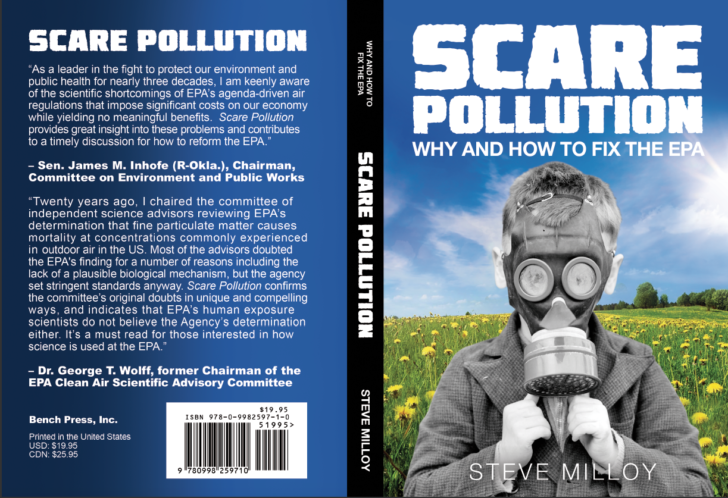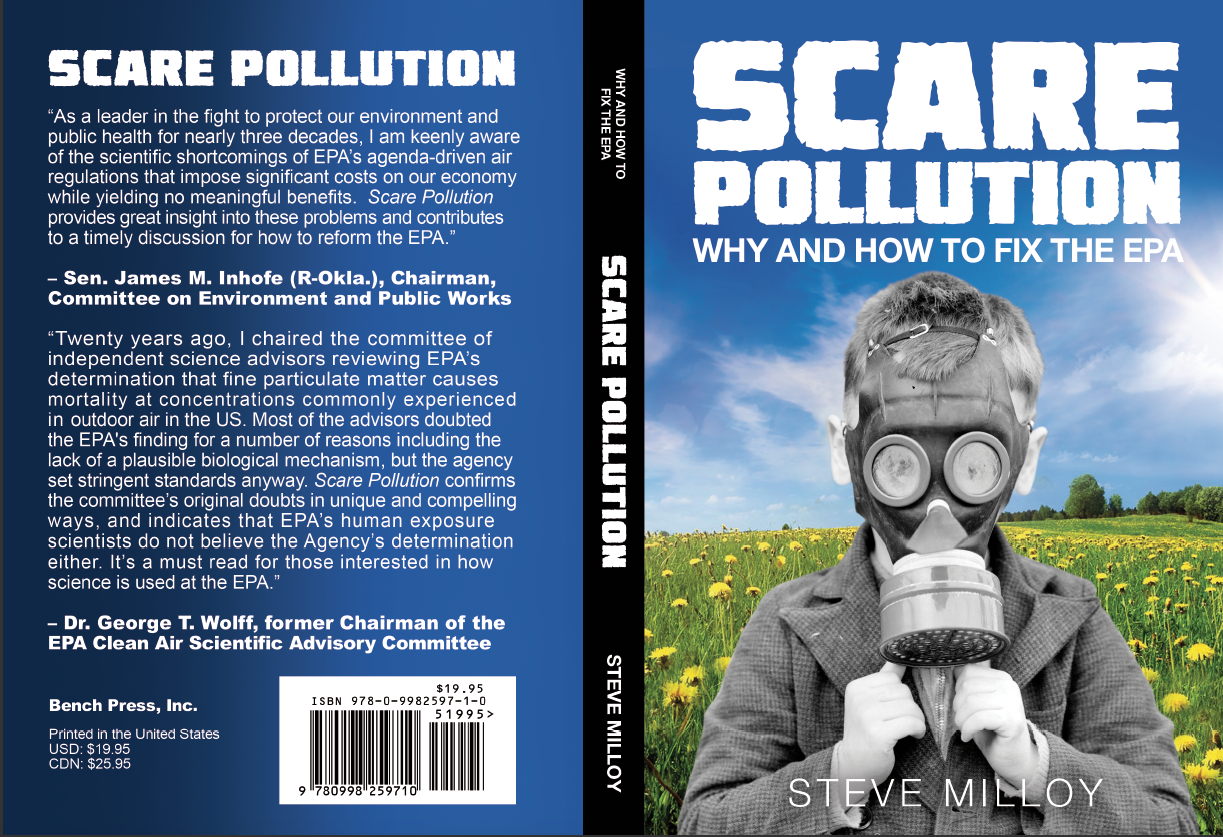As reported by Bloomberg, it’s that damn Milloy guy again… debunking EPA claims with the all-important California PM2.5 data set.

Continue reading Chairman Smith reopens the debate on EPA’s science
As reported by Bloomberg, it’s that damn Milloy guy again… debunking EPA claims with the all-important California PM2.5 data set.

Continue reading Chairman Smith reopens the debate on EPA’s science
But… but…

The baby mice weren’t reported to be overweight or otherwise unhealthy. Mere biological effects (if even true) do not necessarily equate to adverse health effects. Also… mice are NOT little people.
The media release is below.
###
Prenatal bisphenol A exposure weakens body’s fullness cues
Mouse study sheds light on how endocrine-disrupting chemical increases obesity risk
THE ENDOCRINE SOCIETY
WASHINGTON — An expectant mother’s exposure to the endocrine-disrupting chemical bisphenol A (BPA) can raise her offspring’s risk of obesity by reducing sensitivity to a hormone responsible for controlling appetite, according to a mouse study published in the Endocrine Society’s journal Endocrinology.
BPA is a chemical found in a variety of food containers, including polycarbonate plastic water bottles and can linings. BPA can interfere with the endocrine system by mimicking estrogen, one of the main sex hormones found in women. Research indicates BPA exposure is nearly universal. More than 90 percent of people tested in population studies had detectable levels of BPA and compounds produced when it is metabolized by the body in their urine.
As of 2014, nearly 100 epidemiological studies had been published tying BPA to various health problems, according to the Society and IPEN’s Introduction to Endocrine-Disrupting Chemicals.
The new study found mice born to mothers exposed to BPA were less responsive to the hormone leptin, which is sometimes called the satiety hormone. Leptin helps inhibit the appetite by reducing hunger pangs when the body does not need energy. The hormone sends signals to the hypothalamus region of the brain to suppress the appetite.
“Our findings show that bisphenol A can promote obesity in mice by altering the hypothalamic circuits in the brain that regulate feeding behavior and energy balance,” said the study’s senior author, Alfonso Abizaid, Ph.D., of the Department of Neuroscience at Carleton University in Ottawa, Canada. “Low level prenatal exposure to BPA delays a surge of leptin after birth that allows mice to develop the proper response to the hormone. BPA exposure permanently alters the neurobiology in the affected mice, making them prone to obesity as adults.”
To examine how BPA can encourage the development of obesity, the researchers fed pregnant mice BPA in their food. The mice were exposed to doses of BPA that are lower than levels deemed safe by the U.S. Food and Drug Administration and Health Canada. Once the mice gave birth, the researchers gave their offspring injections of leptin at various intervals and then examined their brain tissue and analyzed their blood to gauge the response to the hormone.
Other pregnant mice were not exposed to any chemicals or were exposed to an estrogen chemical called diethylstilbestrol (DES), so their young could be compared to those born to mice that were exposed to BPA. All the mice were fed a control diet to eliminate differences in food intake.
Newborn mice typically exhibit a surge of leptin when they are eight days old that programs the hypothalamus circuits to respond to fullness cues. The study found that animals exposed to BPA experienced this surge two days late, and mice exposed to DES never had a surge of leptin. When they were treated with leptin over the course of two days, control animals that weren’t exposed to either chemical lost more weight than BPA- or DES-exposed mice.
In addition, researchers found that mice exposed to BPA before birth had reduced fiber density and brain activity in the hypothalamus circuits involved in regulating energy expenditure.
“This study improves our understanding of how BPA can disrupt the endocrine system in a manner that raises the risk of obesity in animals,” Abizaid said. “Since BPA has also been linked to obesity in humans, people need to be aware that environmental factors can lead to increased susceptibility to obesity and cardio-metabolic disorders.”
###
Other authors of the study include: Harry MacKay of Baylor College of Medicine in Houston, Texas, and Zachary R. Patterson of Carleton University in Ottawa, Canada.
The research was supported by a Carleton University Research Award given to Abizaid, a Canadian Institutes for Health Research Graduate Scholarship and Ontario Graduate Scholarship awarded to Patterson, and an Ontario Graduate Scholarship given to MacKay.
The study, “Perinatal Exposure to Bisphenol-A (BPA) Delays the Postnatal Leptin Surge in Male and Female CD-1 Mice,” will be published online at https://academic.oup.com/endo/article-lookup/doi/10.1210/en.2016.1718, ahead of print.
The state of climate science is perfectly captured by this media release.

No surprise in these results.

Fewer substances will obviously cause fewer effects. That said, keep in mind that mere exposure does not equal toxicity. Even with tobacco smoking, it’s the dose that makes the poison.
The media release is below.
###
New study compares the effects of direct exposure to cigarette smoke or e-cigarette vapor
MARY ANN LIEBERT, INC./GENETIC ENGINEERING NEWS
New Rochelle, NY, February 1, 2017–Researchers reported changes in the expression levels of 123 genes when reconstituted lung tissue was exposed to cigarette smoke, compared to only two genes that could be confirmed following exposure to e-cigarette aerosols. They also reported increased levels of several cytokines, which are biomarkers of inflammation, in the lung tissue model exposed to conventional cigarette smoke, as described in the study published in Applied In Vitro Toxicology, a peer-reviewed publication from Mary Ann Liebert, Inc., publishers. The article is part of a special issue on Next Generation Nicotine Products and is available to media contacts upon request.
Anisha Banerjee and coauthors from British American Tobacco R&D Centre (Southampton, U.K.) used a commercially available 3D airway culture system comprised of reconstituted human epithelium, which mimics the structure and functions of human lung tissue. The researchers demonstrate how this model system, together with a protocol designed to deliver matched, repeated exposures to smoke or aerosol over a short period, can be applied in the laboratory to assess potential toxicity.
In the article entitled “Differential Gene Expression Using RNA-seq Profiling in a Reconstituted Airway Epithelium Exposed to Conventional Cigarette Smoke or Electronic Cigarette Aerosols,” they describe the molecular techniques used to measure gene expression and inflammatory biomarker levels.
“Next generation sequencing is revolutionizing and expanding the frontiers of genomic research to unravel the genetic information from any biological system,” explains Dr. Banerjee.
“The utilization of new human 3D lung models in combination with the latest gene expression technologies to evaluate the effects of conventional cigarette smoke versus electronic cigarette aerosols demonstrates how in vitro models can be used to understand biological effects,” says Jim McKim, PhD, Editor-in-Chief of Applied In Vitro Toxicology and Founder and CEO, IonTox, LLC.
###
“By all accounts, [the Trump administration was] running around Thursday delivering copies of Steve Milloy’s “Scare Pollution: Why and How to Fix the EPA” to key members of Congress.”
Ridiculous. Transient physiological effects do not translate into little-understood heart disease which is a natural long-term degenerative process.

Continue reading Claim: E-cigarettes increase heart disease risk
I almost spit up my morning cup of liberal tears when I read the WaPo editorial this morning on Trump’s firing of ex-Acting AG Sally Yates.

Continue reading WaPo Hypocrisy: Don’t ‘demonize’ political opponents
‘Milloy literally wrote the book on fixing the EPA.’ Yes, I did.
Watch the video/read the report at KCRG.com.
Buy my book: Amazon | Personalized, signed copy from JunkScience.com Store.
From National Review about my new book “Scare Pollution: Why and How to Fix the EPA.”

“Our work shows that the terrestrial biosphere might have greater potential than previously thought to mitigate climate change by sequestering carbon emissions from fossil fuels.”

What sea-level rise?
Continue reading Claim: Storms Preview Sea-Rise Damage to California Roads, Cities